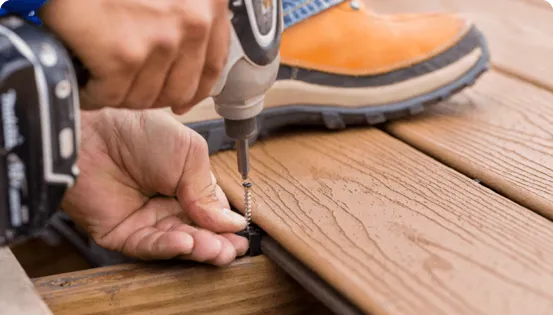Building a fence can be a rewarding DIY project, whether you're a homeowner looking to add privacy or a contractor working on a larger project. However, one crucial aspect that often gets overlooked is the spacing of fence posts. Correctly spaced posts ensure the stability and longevity of your fence, making it essential to get it right.
What is Fence Post Spacing and Why is it Important?
Fence post spacing refers to the distance between individual fence posts. Proper spacing is critical for maintaining the integrity and durability of your fence. Incorrectly spaced posts can lead to sagging, leaning, or even collapse over time.
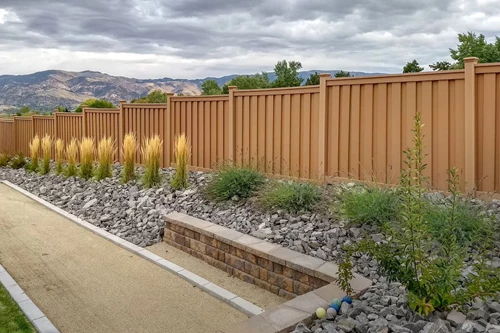
Key Considerations When Spacing Fence Posts
Before you start digging holes for your fence posts, there are a few factors to consider:
- Type of Fence: The material and design of your fence will significantly impact post spacing.
- Purpose of the Fence: Whether you're building a privacy fence, a decorative fence, or a functional barrier, the intended use will dictate the distance between posts.
- Local Regulations: Always check local building codes and regulations, as they may specify minimum or maximum distances between posts.
Are you ready to build a fence? One of the initial key tasks is determining the ideal spacing between your posts. This sounds simple enough, but there are many factors you'll need to consider before you get started, like the type of material you’ll be working with, the length of the fence, the terrain, gate locations, etc. Follow along to discover what can save time and eliminate costly mistakes while transforming your exposed backyard into your own private paradise.
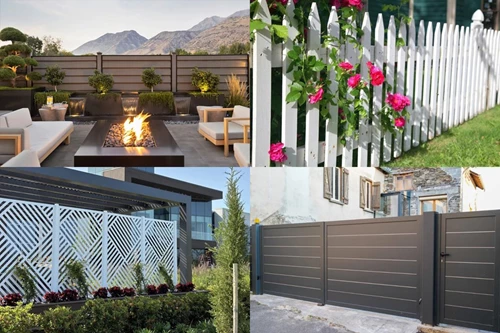
How the Type of Fence Material Impacts Post Spacing
Different materials and fence types require different post spacing to ensure stability and aesthetic appeal. If your fence posts are too far apart, your panel sections can sag, bow, lean, and become unstable. Certain materials can span further than others.
Metal can span further than wood, and wood can span further than vinyl. Many vinyl and composite fence sections will have rails (the horizontal components of a fence panel) with metal support bars incorporated into their design. Commercial steel fence panels can be spaced 10 feet apart or more and some wire farm fences can span much further than that; however, most residential privacy fence posts will be set somewhere between 6 ft. and 8 ft. apart.
- Wood Fences: Typically, wooden fences require posts spaced 6 to 8 feet apart. This spacing provides adequate support for the weight of the wood panels.
- Composite Fences: Composite fences, made from a mix of wood fibers and plastic, generally require posts spaced 6 to 8 feet apart, similar to wood fences, ensuring adequate support and durability.
- Vinyl Fences: Vinyl fences are lighter than wood and can often have posts spaced 8 to 10 feet apart, depending on the design and manufacturer’s recommendations.
- Chain-Link Fences: These fences are usually more flexible and can have posts spaced 10 to 12 feet apart.

How Long is the Fence?
Another major consideration when spacing fence posts is the length of the fence itself. If the length of your fence is going to be 35 ft. long, than it’s not possible that each fence section will be exactly 8ft. wide. In this case, at least some of the fence posts will be located closer than 8 ft. apart (more on this below).
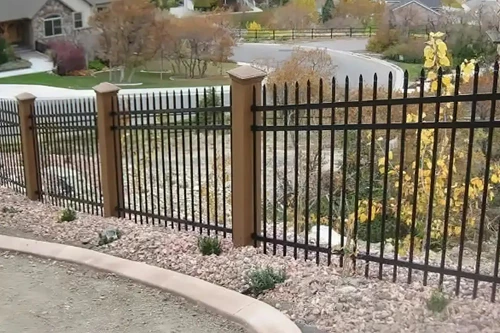
Building a Fence on a Hill
When installing a fence on a hill, the distance between two posts measured horizontally will be shorter than the lengths of the rails if they are installed to follow the contour of the slope. For example, the space between these two posts as measured on a horizontal line is 8 ft. But because the ground is sloped 20 deg., the two rails will be close to 8 ft. 6 in. long. That might exceed the distance the rails of your fence are designed to span.
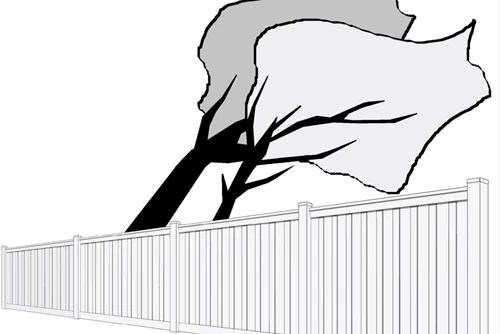
Installing a Fence in Windy Areas
If you live in an area prone to high winds, you may want to opt for closer post spacing, especially if the fence is a taller privacy fence. A 6-ft.-wide panel supported by two posts can withstand stronger wind gusts than an 8-ft. panel.

Installing Fence Gates
Installing a gate within the run of a fence will affect your fence post spacing. You can reduce the number of posts you use if you install the gate between two full-length panels. That way the gate can utilize the full-size panel posts instead of installing two separate posts just for the gate and ending up with two small fence panels on each side.
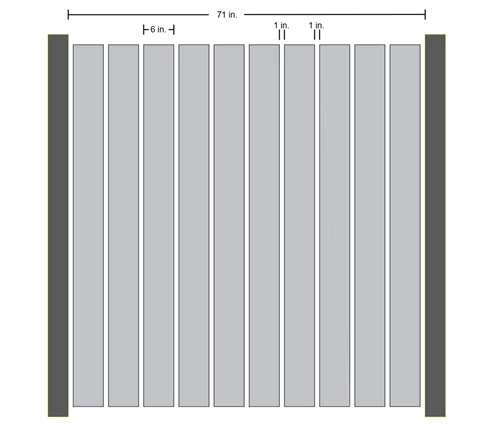
The Size of the Pickets and Picket Spacing
The distance between the posts will determine the size of your panels, which might depend on the size of your pickets and how you space those pickets. It’s visually appealing when you can create panels using all full-size pickets.
For example, let’s say you are trying to create a fence with panels roughly 6-ft.-wide using 6-in. pickets. If you spaced the posts so the distance between them was 71 in. (1 in. less than 6 ft.), then you could use 10 pickets spaced with a 1-in. gap, without having to rip down any pickets. The math gets more complicated when dealing with pickets that are not exactly whole numbers, which most aren’t.
Sometimes it’s easier to figure out post spacing by laying out your actual top and bottom panel rails on the ground and start physically spacing your pickets on them until you find a combination that works best for you.
Fence Manufactures' Recommendations
Each fence manufacturer will have their own requirements when it comes to fence post spacing. Manufacturers of premium fencing will have determined these distances based on extensive and rigorous testing. Also, fence warranties will only be valid if you stay within the specific guidelines, so it’s important to follow the manufacturer's instructions carefully.
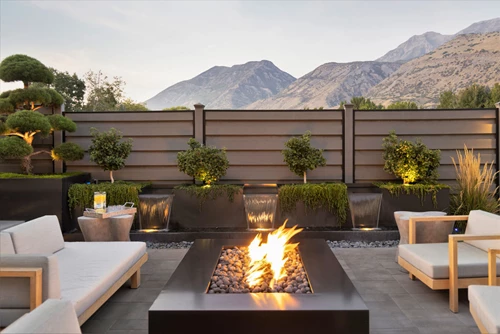
The Cost and Time It Takes to Build a Fence
When working with manufactured fencing, you will save yourself a lot of time if you can space as many of the fence posts as possible at the exact distance the manufacturer recommends. This will greatly reduce the number of rails and pickets you need to cut. When working with horizontal fence pickets, this could eliminate dozens, if not hundreds, of cuts. When working with wood, keep in mind the length of the lumber you are working with. If you set your post just over 8 ft. apart, you will have to buy 10-ft. rail material, whereas if you kept that distance just under 8 ft., you could save money by using 8-ft. lumber instead.
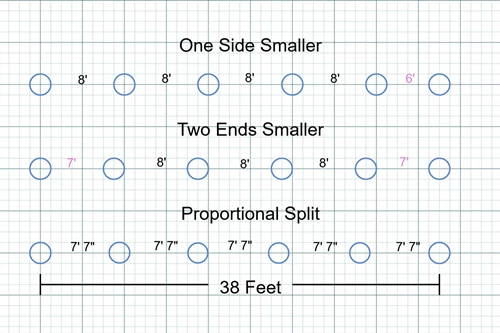
How to Calculate Fence Post-Spacing
Here are some simple equations to help you determine how many posts/panels you will need and how to figure out the distance between the posts. Also included are the three most common methods for post spacing. The one you choose will be based on personal preference and the type of fencing you are working with. The examples here are all based on building a 38-ft. long fence with 8-ft. panels. To keep things simple, the post spacing in these examples will refer to the distance to the center of each post, not the distance between the outer surface of the posts.
NUMBER OF PANELS REQUIRED:
- 38 ÷ 8 = 4.75
- (desired length of the fence) ÷ (length of each panel) = (number of panels needed*)
- *If the sum is not a whole number add 1. So, in this case 4.75 = 5 panels total.
HOW MUCH SHORTER ONE OR MORE PANELS NEED TO BE:
- 40 – 38 = 2
- (length of 5, 8-ft. panels) - (desired length of the fence) = (total number of ft. you need to shorten one or more panel)
OPTION #1: ONE SMALLER END-PANEL:
- 38 – 2 = 6
- (desired length of the fence) - (number of ft. one panel needs to be shortened) = (length of the smaller panel)
OPTION #2: TWO SMALLER END-PANELS:
- 8 x 3 = 24, 38 – 24 = 14 ÷ 2 = 7
- (desired length of the fence) – (length of the three full panels*) = (distance the remaining two panels need to span) ÷ (number of partial panels) = (length of each smaller panel)
- *Since there are two panels (one at each end) smaller than 8 ft., you will only have 3 full panels between them.
OPTION #3: PROPORTIONAL SPLIT BETWEEN ALL POSTS:
- 38 ÷ 5 = 7.6 (or roughly 7 ft. 7 in.)
- (total length of the fence ÷ (total number of panels) = (length of each panel)

How many Fence Posts do You Need?
It’s important to create a diagram that illustrates the fence you plan to build and make sure you include any gates. One common mistake is to assume that you need the same number of posts as there are panels, when in fact you’ll need one more. For example, one length of fence with five panels will require six posts.
Fence Post Spacing Tips:
- Measure Twice, Dig Once: Ensure accurate measurements before digging to avoid unnecessary adjustments.
- Use a String Line: A string line will help keep your posts aligned and ensure uniform spacing.
- Concrete Footings: For added stability, especially for fences in windy areas, consider setting your posts in concrete.
- Post Depth: The depth of your post holes should be at least one-third to one-half the height of the post above ground. This ensures sufficient stability, especially for taller fences.
- Call 811 before you choose post locations.
- Get fence location approved by your municipality’s building/zoning department.
- Avoid irrigation/sprinkler pipes (these won’t be located by your utility companies).
- Invest in a 100-ft. tape measure for longer fences
- Post thickness: The space between two posts set 8 ft. apart on-center will be less than 8 ft.
Proper fence post spacing is vital for the structural integrity and longevity of your fence. By considering the type of fence, its purpose, and the size of the panels, you can determine the optimal spacing for your project. Always remember to check local regulations and follow best practices to ensure a successful installation.





